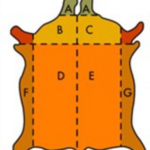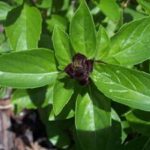The process of tanning leather hides date back as far as 2500BC and was a trade conducted mostly by the poor and restricted to the outskirts of towns due to it being considered a noxious or odoriferous trade if you will. Some of the reasons of this “ordorific” horror other than the obvious decaying animal carcass was the materials used such as urine and feces that were used to prevent further decaying, along with salts and lime. Ancient man would have hardly survived without animal hides and tanning processes, noxious or not due to the many items rendered from animal hides such as armor, bags, boots and sandals.
Mineral Tanning Leather Method
Alum Tanning Leather Hides
This use of Alum in tanning leather is produced by combining a solution of aluminum and potassium sulfate and placing it on a hide resulting in a white hide and produces a very strong leather. Alum tanning also affords a tanner to process hides a process further based on the usage latter with other materials as to achieve grain affects, coloring or tone.
Chrome Tanning Leather Hides
Chrome (Chromium Sulfate) tanning a leather hide is the widely used methods amongst industrialized nations around the globe. This process renders a “wet-blue” hide that will also see some type of further tanning method based on the usage of the leather hides. Chrome Alum (Potassium Chrome Alum) tanning of leather hide is a specially conducted method used almost exclusively for furs. This leaves the leather hide nearly white in color.
Zirconium Tanning Leather Hides
Zirconium salts have been used as a means of tanning leather hides producing another almost white in color leather hide, with results render a firmer body of the leather hide, and with a tighter grain pattern.
Aldehyde Tanning Leather Method
Is a process method using Formaldehyde, where it is mixed with water to create a chemical solution of is dissolved into water to create a chemical solution of formalin. This is used most commonly used on deerskins and renders the leather hide white. This process also allows the leather hide washable properties and leaves the leather hide with a “crackle” or distressed look and grain. This tanning method or process is problematic due to the fact hides will yellow with age and being idle. Glutaraldehyde has become a replacement for formaldehyde as a tanning agent because it lacks the yellowing that occurs with age and leaves the leather hide not so white as the above mentioned method. This process also allows the hide further tanning processes based on usage of the leather hide(s).
Liritan Tanning Leather Method
The Liritan tanning leather method is the mostly commonly used in the United States using Calgon (sodium hexametaphosphate) in soaking pits that are a weaker tanning solution that expedites the tanning process faster than the traditional method of vegetable tanning of leather hides which are commonly a very slow process. This is used for mass production of tanning leather hides and the most cost effective. This process is not all about saving money but a means of rendering a very even tannage due to the solution used is increased in strength and potency in each soaking pit during the tanning process.
Oil Tanning Leather Method
The oil tanning method of leather hides are another exclusive and dedicated process solely conducted to render chamois-type leather for their excellent water absorbency properties. Typically the hides are from lamb or sheep where Cod Liver Oil in an unoxidized form. This leaves tanned hides made for garments, gloves and filtration products.
Vegetable Tanning Leather Method
Vegetable tanning leather is the process in which natural materials are used. It is the most traditional form of such. The many additives used in the vegetable tanned methods range from derivatives from certain plants such as bark, fruit, leaves or wood. Each natural ingredient leaves a different affect of the leather in color, tone and firmness.
Chestnut extract for example is extensively used in EU countries and renders a medium brown tone and a tight grain. Leaves of the Sumac shrub produced leather with a greenish-yellow tone and allows great dyeing properties in a finished leather craft item. It is typically used for bookbinding leather due to its resistance to aging and soft temper.
Catechol can be used for tanning a leather hide because it renders a reddish brown tone, a pebble-like grain, but is susceptible to shrinkage.
Hemlock was traditionally used in North America in the 1800’s for the production of shoe and boot soles. This fir tree extract renders another reddish-brown tone and is extremely strong and tough.
Mimosa is a product of South African from the bark of Mimosa trees. It also produces a leather with a reddish-brown tone and darkens when exposed to direct sunlight. Almost all leather hides will darken when exposed to sunlight.
Oak Bark was used during the period of our Founding Fathers and renders a grayish-brown tone of the leather hide but is very firm in temper, however very flexible as well.
Pine Bark is another EU method producing a reddish-brown tone to the end-result tanned leather hide.
Sources:
Raymond J. Johnson
Steven Siegel
The Leather Factory





